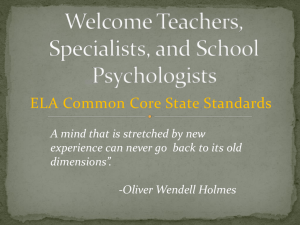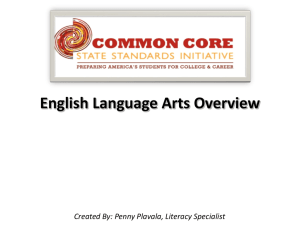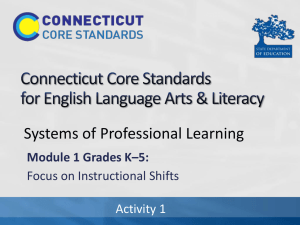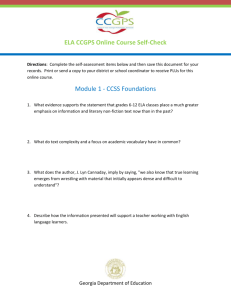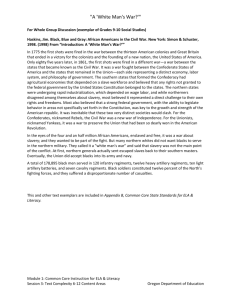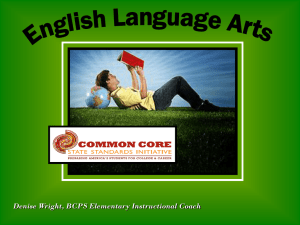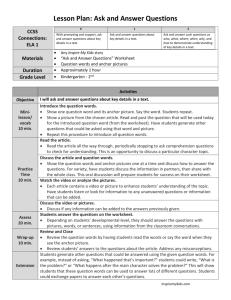Module 1: A Closer Look at the Common Core State Standards for
advertisement
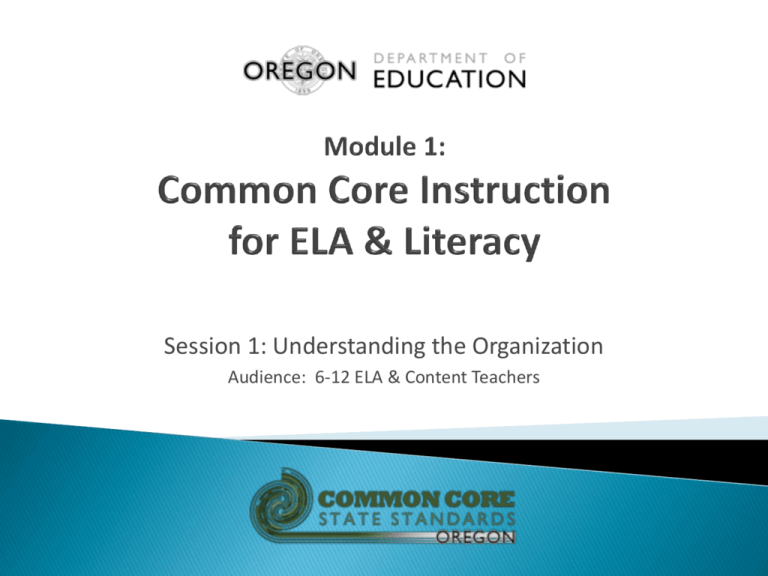
Session 1: Understanding the Organization Audience: 6-12 ELA & Content Teachers Understand that the College and Career Readiness (CCR) Anchor Standards ◦ Define cross-disciplinary literacy expectations needed for students to enter college and workforce training programs; ◦ Provide the organizational “backbone” of the grade-specific Common Core State Standards (CCSS) for English Language Arts (ELA) and Literacy in History/Social Studies, Science, and Technical Subjects, except for the Foundational Skills; ◦ Are organized into four strands with subheadings under each; ◦ Depict an integrated model of literacy. Understand that grade specific CCSS ◦ Describe what all students should know and be able to do at the end of each grade or grade band. 2 K-12 Mathematics K-5 English Language Arts K-12 ELA/Literacy 6-12 History/ Social Studies Appendices A, B, C Science & Technical Subjects Common Core State Standards 3 Most reading in college & workforce training is informational in structure and challenging in content, with a higher volume expected and little scaffolding provided. At the secondary level, many reading and writing demands on students are specific to the disciplines, and are best understood and addressed by experts in the fields. E.g., ◦ Understanding hierarchical structures; analyzing primary and secondary sources; following precisely multistep procedures, etc. ◦ Understanding the different types of evidence (e.g., documentary, experimental) called for academic writing in different disciplines Students can develop mutually reinforcing skills for reading and writing across a range of texts and disciplines. 4 College and Career Readiness (CCR) Anchor Standards are divided into four interrelated literacy strands. College & Career Readiness Anchor Standards Reading Writing Speaking & Listening Language 5 The CCRs in each literacy strand are grouped into sections by subheadings. For example, Reading Key Ideas and Details Craft and Structure Integration of Knowledge and Ideas Range of Reading & Level of Text Complexity 6 Read through the CCR standards for READING under each subheading. In groups, discuss how the standards under each subheading are related. How are they distinct from those under other subheadings? Jot down phrases to describe the relationships or distinctions. 7 Writing ◦ ◦ ◦ ◦ Text Types and Purposes Production and Distribution of Writing Research to Build and Present Knowledge Range of Writing Speaking and Listening ◦ Comprehension and Collaboration ◦ Presentation of Knowledge and Ideas Language ◦ Conventions of Standard English ◦ Knowledge of Language ◦ Vocabulary Acquisition and Use 8 Take a minute to read through the CCR anchor standards of the Writing, Speaking and Listening, and Language strands. In groups, highlight or mark the CCR anchor standards in Writing, Speaking and Listening, and Language that are closely connected to the Reading CCRs. 9 What interrelationships did you notice with the Language strand? Others? Research and media skills are blended into the Standards as a whole. Find examples throughout the strands. 10 Describe what all students should know and be able to do at the end of each grade or grade band. ◦ Grade level standards at each grade K - 8 ◦ Grade band standards at high school: 9-10 and 11-12 Using a “back-mapping” design, grade-specific K-12 CCSS translate the aims of the CCR anchor standards into age- and attainment-appropriate terms. 11 English Language Arts Reading Literacy in Content Areas Reading Literature Literary Nonfiction Informational Text Writing Writing Speaking & Listening Language 12 CCR READING K-5 ELA & History/SS Science & Tech 6-12 ELA 6-12 History/SS 6-12 Science & Technical Subj Key Ideas & Details 1. 2. 3. Key Ideas & Details 1. 2. 3. Key Ideas & Details 1. 2. 3. Key Ideas & Details 1. 2. 3. Key Ideas & Details 1. 2. 3. Craft & Structure 4. 5. 6. Craft & Structure 4. 5. 6. Craft & Structure 4. 5. 6. Craft & Structure 4. 5. 6. Craft & Structure 4. 5. 6. Integration of Knowledge & Ideas 7. 8. 9. Integration of Knowledge & Ideas 7. 8. 9. Integration of Knowledge & Ideas 7. 8. 9. Integration of Knowledge & Ideas 7. 8. 9. Integration of Knowledge & Ideas 7. 8. 9. Range of Reading & Level of Text Complexity 10. Range of Reading & Level of Text Complexity 10. Range of Reading & Level of Text Complexity 10. Range of Reading & Level of Text Complexity 10. Range of Reading & Level of Text Complexity 10. 13 Reading CCR #5: Analyze the structure of texts, including how specific sentences, paragraphs, and larger portions of the text … relate to each other and the whole. 9-10.RI.5: Analyze in detail how an author’s ideas or claims are developed and refined by particular sentences, paragraphs, or larger portions of a text …. 6-8.H.5: (History/Social Studies) Describe how a text presents information (e.g., sequentially, comparatively, causally). 4.RI.5: Describe the overall structure (e.g., chronology, comparison, cause/effect, problem/solution) of events, ideas, concepts, or information in a text or part of a text. K.RI.5: Identify the front cover, back cover, and title page of a book. 14 9-10.RL.3 Analyze how complex characters (e.g., those with multiple or conflicting motivations) develop over the course of a text, interact with other characters, and advance the plot or develop the theme. 9-10.RI.3 Analyze how the author unfolds an analysis or series of ideas or events, including the order in which the points are made, how they are introduced and developed, and the connections that are drawn between them. 9-10.RH.3 Analyze in detail a series of events described in a text; determine whether earlier events caused later ones or simply preceded them. 9-10.RST.3 Follow precisely a complex multistep procedure when carrying out experiments, taking measurements, or performing technical tasks, attending to special cases or exceptions defined in the text. 15 Examine the Common Core State Standards at your own grade level ◦ Find connections among the Reading standards and those in Writing (and for ELA, among the additional two strands). How might teachers at your level integrate standards from two or more strands into small units or complex tasks? 16 Decode the alphabet soup. ◦ ELA, RL/RI/RST/RH, CCSS, CCR How are the CCR and the grade-specific Common Core State Standards related? Different? Recall the four strands in the Common Core State Standards for English Language Arts & Literacy in the content areas. (ELA) Briefly explain how one Language standard could be integrated into a reading, writing, or speaking/ listening task. 17 The Common Core State Standards define what all students are expected to know and be able to do. The Oregon Literacy Plan addresses in detail how comprehensive reading programs can support student success. ◦ Subsequent sessions will address instructional implications of the CCSS for Oregon teachers and highlight resources in K-12 Teachers: Building Comprehension in the Common Core. ◦ Sneak a peek: “Using an Integrated Model of Literacy” classroom snapshots, p R-39 to R-46 http://www.ode.state.or.us/teachlearn/subjects/elarts/readin g/literacy/have-you-ever.pdf 18
